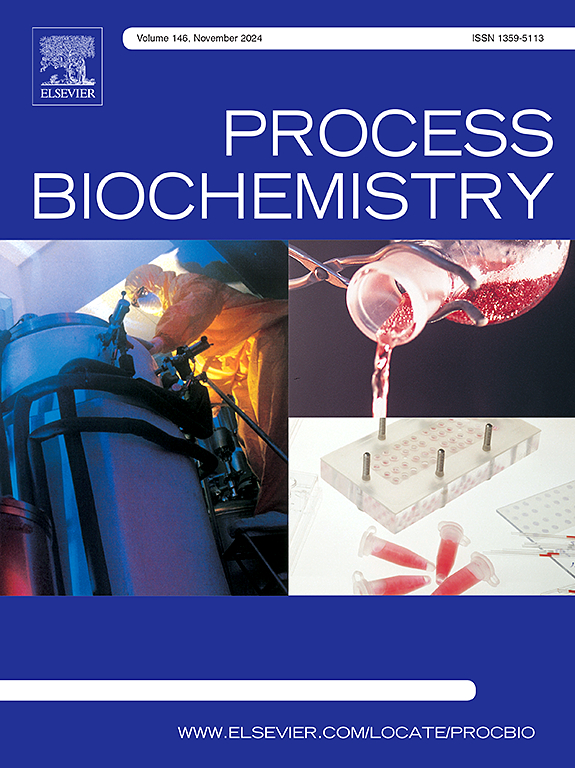Understanding in-vivo refolding of antibody fragments (Fab): Biosimilar Ranibizumab a case study
IF 3.7
3区 生物学
Q2 BIOCHEMISTRY & MOLECULAR BIOLOGY
引用次数: 0
Abstract
In-vitro protein refolding is a major bottleneck step in the large-scale manufacturing of antibody fragments expressed in a microbial host system. The formation of an inter-chain disulfide bond is a key rate-limiting step during in-vitro refolding of antibody fragment therapeutics. In this investigation, we report the use of two redox mutant strains of E. coli viz., SHuffle® T7 (DE3) and SHuffle® T7 Express (DE3) possessing an oxidizing cytoplasm for the soluble expression of a refolded biosimilar antibody fragment. The effect of various critical process parameters on antibody fragment refolding yield was studied using a Design of Experiment (DoE) approach. The optimized upstream processing led to the expression of 167 ± 2.53 mg/L and 95 ± 1.44 mg/L of soluble refolded biosimilar Ranibizumab using the SHuffle® T7 (DE3) and SHuffle® T7 Express (DE3) strains, respectively, at the bioreactor scale. Physicochemical characteristics of the in-vivo refolded antibody fragment were studied and compared with an innovator molecule using various orthogonal analytical methods. A biological activity study of in-vivo refolded Ranibizumab using HUVEC cell-based bioassay proved that cell proliferation inhibition is comparable to the innovator Ranibizumab. The proposed strategy offers a time and cost-effective manufacturing platform for antibody fragments.
了解抗体片段(Fab)的体内再折叠:生物仿制药拉尼珠单抗案例研究
体外蛋白质重折叠是大规模生产在微生物宿主系统中表达的抗体片段的主要瓶颈步骤。链间二硫键的形成是抗体片段治疗体外重折叠过程中的关键限速步骤。在这项研究中,我们报告了使用两种氧化还原突变的大肠杆菌菌株,即 SHuffle® T7 (DE3) 和 SHuffle® T7 Express (DE3),它们具有氧化细胞质,用于可溶性表达再折叠的生物类似抗体片段。实验设计(DoE)方法研究了各种关键工艺参数对抗体片段重折叠产量的影响。通过优化上游处理,使用 SHuffle® T7 (DE3) 和 SHuffle® T7 Express (DE3) 菌株在生物反应器规模上分别表达了 167 ± 2.53 mg/L 和 95 ± 1.44 mg/L 的可溶性再折叠生物仿制药雷珠单抗。使用各种正交分析方法研究了体内重折叠抗体片段的理化特性,并与创新分子进行了比较。使用基于 HUVEC 细胞的生物测定法对体内重折叠的雷珠单抗进行的生物活性研究证明,其细胞增殖抑制作用与创新药雷珠单抗相当。所提出的策略为抗体片段的生产提供了一个省时、经济的平台。
本文章由计算机程序翻译,如有差异,请以英文原文为准。
求助全文
约1分钟内获得全文
求助全文
来源期刊

Process Biochemistry
生物-工程:化工
CiteScore
8.30
自引率
4.50%
发文量
374
审稿时长
53 days
期刊介绍:
Process Biochemistry is an application-orientated research journal devoted to reporting advances with originality and novelty, in the science and technology of the processes involving bioactive molecules and living organisms. These processes concern the production of useful metabolites or materials, or the removal of toxic compounds using tools and methods of current biology and engineering. Its main areas of interest include novel bioprocesses and enabling technologies (such as nanobiotechnology, tissue engineering, directed evolution, metabolic engineering, systems biology, and synthetic biology) applicable in food (nutraceutical), healthcare (medical, pharmaceutical, cosmetic), energy (biofuels), environmental, and biorefinery industries and their underlying biological and engineering principles.
 求助内容:
求助内容: 应助结果提醒方式:
应助结果提醒方式:


